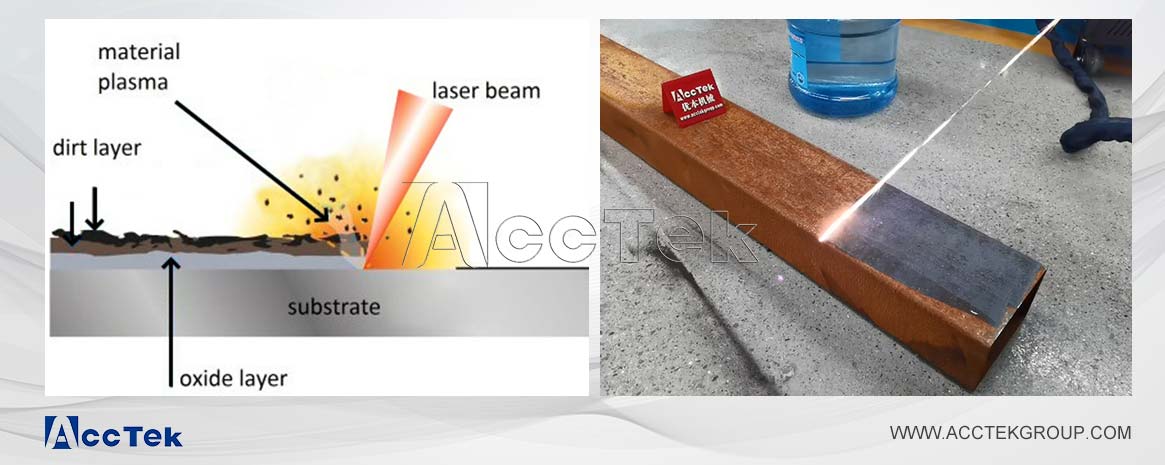In 1960, the world's first laser was born. In the time that followed, scientists created lasers for use in various fields. The development and innovation of laser technology has promoted the progress of society. In recent years, the application of laser in the field of cleaning has also achieved important results. Compared with traditional cleaning methods such as mechanical friction, chemical corrosion, and high-frequency ultrasonic waves, laser cleaning has the advantages of high effect, low cost, no pollution to the environment, no damage to the substrate, and a wide range of materials. The emergence of
laser cleaning machine is completely in line with the concept of environmental protection processing, and it is the most reliable and effective cleaning method at present.
The whole process of laser cleaning is roughly divided into four steps:
1. Laser vaporization decomposition
2. Laser lift-off
3. Thermal expansion of pollutant particles
4. Vibration on the surface of the material separates the contaminants
Laser cleaning is to use the energy density, direction control and convergence ability of the laser beam to destroy the bonding force between the pollutant and the substrate or directly vaporize the pollutant. Thereby reducing the bonding strength of the pollutant and the substrate to achieve the purpose of cleaning the surface of the material. As shown in the figure, after the contaminants on the surface of the workpiece absorb the energy of the laser, they undergo rapid vaporization or instantaneous thermal expansion to overcome the force between the contaminants and the surface of the substrate. Due to the increased heating energy, the contaminant particles vibrate and fall off the surface of the substrate.

Of course, during the operation of the laser cleaning machine, attention should be paid to the laser cleaning threshold of the material to be cleaned, and the appropriate laser wavelength should be selected to achieve the best cleaning effect. By setting the laser parameters, it can complete laser rust removal, laser paint removal, laser oil removal and other processes without damaging the surface of the substrate. The cleaning effect is primarily affected by the beam characteristics, the physical factors of the substrate and fouling materials, and the ability of the fouling to absorb the beam energy.
Laser Cleaning Method
Dry Laser Cleaning
The beam emitted by the
pulsed laser cleaning machine directly irradiates the surface of the material to increase the energy absorption temperature of the substrate or surface contaminants, so that the substrate thermally expands or vibrates, and then the contaminants are separated.
This method can be roughly divided into two cases: one is that the surface contaminants absorb laser expansion; the other is that the substrate absorbs the laser to generate thermal vibration.
Wet Laser Cleaning
Wet laser cleaning is to clean the surface of the workpiece before the pulsed laser irradiation, and precoat the liquid film. Under the action of the laser, the temperature of the liquid film rises rapidly and evaporates. At the moment of vaporization, a shock wave acts on the contaminant particles, causing them to dislodge from the substrate. This approach requires the substrate to not react with the liquid film, limiting the range of materials it can be applied to.
Laser Plasma Shockwave
The laser plasma shock wave is a spherical plasma shock wave formed by breaking through the air medium when the laser is irradiated. The shock wave acts to clean the surface of the substrate, releasing energy to remove contaminants. Since the laser does not interact with the substrate, there is no risk of injury. Laser plasma shock wave cleaning technology can remove particles as small as tens of nanometers, and the laser wavelength is not limited.
In actual production, a variety of testing techniques and laser cleaning related parameters should be selected as needed to obtain high-quality cleaned workpieces. In the laser cleaning process, evaluating the surface cleaning efficiency and quality is an important criterion for judging the quality of laser cleaning technology.
The wide application of
laser cleaning is of great significance in industrial production. It provides a cost-effective cleaning solution that reduces cleaning time and improves cleaning fineness. This cleaning process requires few consumables and can be used with electricity. As a result, laser cleaning systems are one of the least expensive and most environmentally friendly rust removal technologies that can solve many challenges in industrial cleaning applications.



